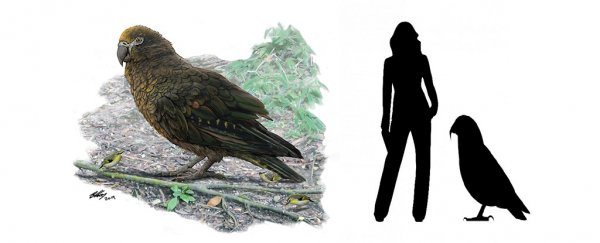A collection of bird bones sat in lab storage for more than a decade, believed to be the remains of an ancient eagle. Little did scientists know what was hiding in the fossils: "Squawkzilla."
Heracles inexpectatus was discovered by scientists in New Zealand, according to a study published Wednesday. At about 3 feet (1 meter) tall, the bird would probably have stood nearly as tall as the average American 4-year-old.
Scientists have been finding enormous prehistoric birds for years, but this one still shocked them. It's the largest parrot ever known to have walked the Earth. It might have even preyed on other birds.
At an estimated 15 pounds (7 kilograms), the now-extinct bird beats out all the other parrot competitors, at nearly double the weight of the endangered kakapo, New Zealand's reigning giant parrot.
The scientists approximated its size based on two leg bones, called tibiotarsi, under the assumption that they both came from the same bird. The researchers compared the drumstick-like bones to bird skeletons in the South Australian Museum collection and the Smithsonian National Museum of Natural History's electronic collection.
The fossils were dug up in 2008 in St Bathans, New Zealand, where many thousands of bird bones have been found.
The large bones, believed to be the bones of an ancient eagle, flew under the radar for a decade. It was during a research project in the lab of Flinders University paleontologist Trevor Worthy that graduate student Ellen Mather rediscovered the bones.
After that, a team of researchers began reanalyzing the findings earlier this year, according to the BBC.
"It was completely unexpected and quite novel," Worthy, the study's lead author, told National Geographic. "Once I had convinced myself it was a parrot, then I obviously had to convince the world."
The bird probably lived during the Early Miocene, which spanned from about 23 million to 16 million years ago.
Researchers concluded that the bird probably couldn't fly and consumed what was along the ground and easy to reach, according to National Geographic. But that might not have been enough to satiate the giant parrot.
It's possible the bird had more carnivorous ways, like another New Zealand parrot, the kea, which has been known to attack and subsequently munch upon living sheep, the magazine reported.
Michael Archer, a co-author of the research and paleontologist at the University of New South Wales, told National Geographic that Heracles might have even been eating other parrots, giving way to a nickname: "Squawkzilla."
Archer told Agence France-Presse the bird had "a massive parrot beak that could crack wide open anything it fancied."
Heracles probably won't be the final unforeseen fossil from the St Bathans area, Worthy told AFP. The researchers have turned up many surprising birds and animals over the years.
"No doubt there are many more unexpected species yet to be discovered in this most interesting deposit," Worthy said.
2019 © The Washington Post
This article was originally published by The Washington Post.
